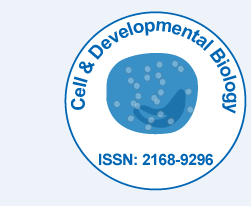
Cell & Developmental Biology
Open Access
ISSN: 2168-9296

ISSN: 2168-9296
Opinion Article - (2024)Volume 13, Issue 6
The accelerating rate of technological development is revolutionizing molecular cell biology. Equipment propels in computerization, DNA sequencing, mass spectroscopy and different types of microarray examination permit huge scope genomic and proteomic investigations. Bio-informatics progresses permit progressively complex cross examination and management of exponentially growing datasets. Techniques like PCR, GFP/FRET and RNAi have led to quantum leaps in test complexity [1].
The accelerating rate of technological development is revolutionizing molecular cell biology. Equipment propels in computerization, DNA sequencing, mass spectroscopy and different types of microarray examination permit huge scope genomic and proteomic investigations. Bio-informatics progresses permit progressively complex cross examination and management of exponentially growing datasets. Techniques like PCR, GFP/FRET and RNAi have led to quantum leaps in test complexity [1]. These improvements have brought about a re-evaluating of the science landscape, with an expanded dependence on innovation driven core facilities at research establishments and global examination consortia, as well as the accessibility of huge datasets produced by non-speculation driven exploration. No single region has been impacted more by these advancements than atomic science. Initially, the term was related with the investigation of DNA around the center of the last century, moored by the emotional imagery of the twofold helix. It then, at that point, advanced to remember atomic occasions for the more extensive sense, like record and chromatin, outlined by cell and formative science, hereditary qualities and organic chemistry. From that point forward, the term has taken on a completely new significance [2]. It presently portrays a bunch of fundamental procedures utilized by most of bioscience research centers: for instance, nowadays a pathology lab depends as much on sub-atomic methodologies as on present day imaging strategies, and a formative lab will work from the customary portrayal of epigenetic connections to the documentation of such pathways at the sub-atomic level. Thusly, the customary 'atomic researcher' is very nearly termination, not on the grounds that she has capitulated to unrivaled methodologies, but instead on the grounds that sub-atomic science has developed to pervade all strolls of science. The sub-atomic science insurgency is additionally forming the diary land-scape. Beside the new yield of diaries covering the region, laid out diaries, for example, Nature Cell Biology and Nature Structural Biology have progressively adjusted to include the term throughout the long term. Right now, it merits taking stock momentarily. NSB has become progressively centered on work, finishing this month in the declaration of another title to all the more likely mirror this more extensive degree. NCB has followed a correlative way by extending its extension into the atomic space. Significantly, this isn't happening at the cost of studies in cell science: atomic science basically gives the instruments expected to a robotic comprehension of cell natural peculiarities. As far as degree, we have added pages to cover handles that are a lot of a piece of cell science, however that generally are some of the time more adjusted to more established translations of the term 'atomic science'. These incorporate fields, for example, the phone cycle and DNA fix, chromatin, record and interpretation, protein corruption and collapsing, and signal transduction. Conventional central focuses in cell science, for example, the cytoskeleton and layer traffic, stay particularly at the core of this diary. Albeit the quality and the protein are the fundamental utilitarian units of molecular cell biology, the cell is the useful unit of life. NCB is keen on how cells work, and this incorporates fostering a comprehension of their inward operations, yet in addition critically the way that a phone cooperates with its current circumstance as well as the other way around. Generally, the extent of this diary envelops all concentrates on that connect with cell biology [3]. The coming of RNAi, for instance, has added one more 'loss-of-work' procedure that makes this fundamental line of trial and error sensibly possible in practically any setting. Additionally, the accessibility of genomic successions for a large portion of the inclined toward model frameworks work with cloning and cross-species correlations, and fluorescent protein labels permit appraisal of proteins and protein cooperation in their local climate.
NCB favors studies with an accentuation on physiological pertinence at the cell and organismal level. By the by, we have an affinity for system, which might expect in vitro and for sure biophysical approaches. NSB approaches atomic robotic understanding from a corresponding point by stressing propels at the definite sub-atomic level regularly based on structure-work connections. Think in vivo and micron for NCB and in vitro and angstrom for NSMB. Together, we desire to cover the entire range of sub-atomic science. Encased with this issue is an enhancement on imaging in cell science that has been delivered related to Nature Reviews Molecular Cell Biology. This series of exceptionally appointed articles was chosen in counsel with specialists locally. The subjects picked plan to feature the assorted imaging methods that have become so fundamental for tending to key cell natural inquiries.
Citation: Masui T (2024). Opinion on Molecular biology, Cell Biology and NCB. Cell Dev Biol.13:375.
Received: 01-Oct-2024, Manuscript No. CDB-24-15785; Editor assigned: 04-Oct-2024, Pre QC No. CDB-24-15785 (PQ); Reviewed: 18-Oct-2024, QC No. CDB-24-15785; Revised: 25-Oct-2024, Manuscript No. CDB-24-15785 (R); Published: 01-Nov-2024 , DOI: 10.35248/2168-9296.24.13.375
Copyright: © 2024 Masui T. This is an open-access article distributed under the terms of the Creative Commons Attribution License, which permits unrestricted use, distribution, and reproduction in any medium, provided the original author and source are credited.